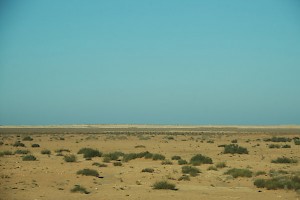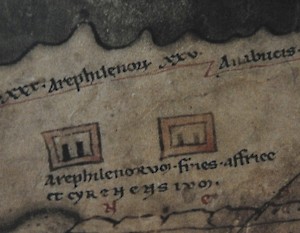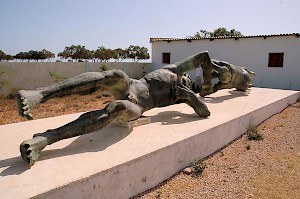Arae Philaenorum (Ras al-A'ali) - Livius (original) (raw)
Arae Philaenorum: town on the border between the Carthaginian and Greek part of ancient Libya, modern Ras al-A'ali.
The area of Ras Lanuf
In his History of the Jugurthine War, the Roman author Sallust (86-34 BCE) informs us about the early history of Lepcis Magna, and digresses on a remarkable incident: how the border between Carthage and Cyrene was drawn.note[Sallust, History of the Jugurthine War 79.]
Since the affairs of the people of Lepcis have brought us to this region, it seems fitting to relate the noble and memorable act of two Carthaginians; the place calls the event to mind. At the time when the Carthaginians ruled in the greater part of Africa, the people of Cyrene were also strong and prosperous. Between that city and Carthage lay a sandy plain of monotonous aspect. There was neither river nor hill to mark the frontiers, a circumstance which involved the two peoples in bitter and lasting strife.
After many armies and fleets had been beaten and put to flight on both sides, and the long struggle had somewhat wearied them both, they began to fear that presently a third party might attack victors and vanquished in their weak state. They therefore called a truce and agreed that on a given day envoys should set out from each city and that the place where they met should be regarded as the common frontier of the two peoples. Accordingly, two brothers were sent from Carthage, called Philaeni, and these made haste to complete their journey. Those from Cyrene went more deliberately. Whether this was due to sloth or chance I cannot say, but in those lands a storm often causes no less delay than on the sea; for when the wind rises on those level and barren plains, it sweeps up the sand from the ground and drives it with such violence as to fill the mouth and eyes. Thus one is halted because one cannot see.
Arae Philaenorum on the Peutinger Map
Now when the men of Cyrene realized that they were somewhat belated and feared punishment for their failure when they returned, they accused the Carthaginians of having left home ahead of time and refused to abide by the agreement; in fact they were willing to do anything rather than go home defeated. But when the Carthaginians demanded other terms, provided they were fair, the Greeks gave them the choice, either of being buried alive in the place which they claimed as the boundary of their country, or of allowing the Greeks on the same condition to advance as far as they wished. The Philaeni accepted the terms and gave up their lives for their country; so they were buried alive. The Carthaginians consecrated altars on that spot to the Philaeni brothers, and other honors were established for them at home. I now return to my subject.note[The translation was made by J.C. Rolfe, and was taken from LacusCurtius.]
This place, marked by the tombs of two brothers, was to remain the border between the two Roman provinces of Africa Proconsularis and Cyrenaica, the Western and Eastern Roman Empire, and - much later - the Zirid and Fatimid rulers of Tunisia and Egypt.
The Fascist statues of the two brothers
Although the altar mentioned in the text was real (it is shown on the Peutinger Map) and human sacrifice was not unheard-of, Sallust's account is essentially folklore: similar stories are told about two Swiss cantons and the Dutch-French frontier on the Caribbean island of Saint Martin. Writing at the beginning of our era, the Graeco-Roman geographer Strabo of Amasia mentions that the monument consisted of two pillars but that the altars no longer remain.note[Strabo, Geography 3.5.5-6.]
When Libya was an Italian colony, the Fascist governor Italo Balbo (1896-1940) dedicated an honorific arch to the Philaeni in nearby Ras Lanuf. It was later demolished, but the statues of the two men can still be seen at Medinet Sultan, about forty kilometers west of Ras Lanuf.


